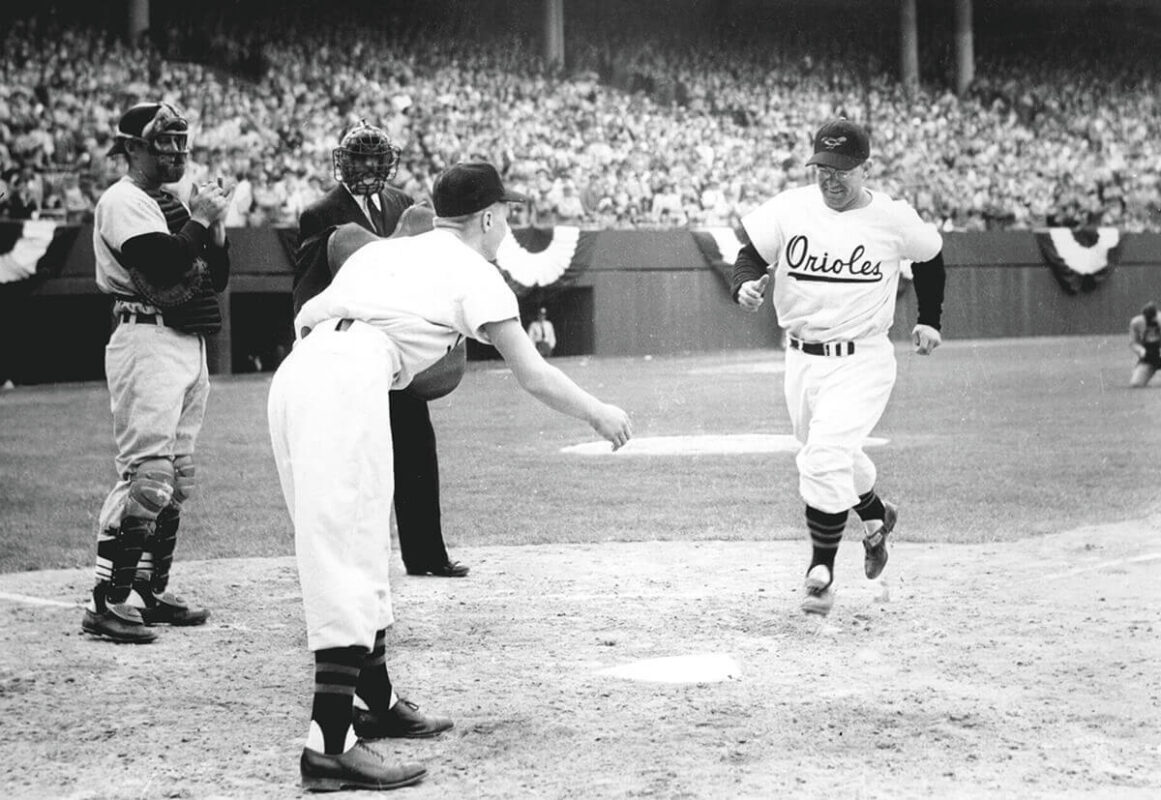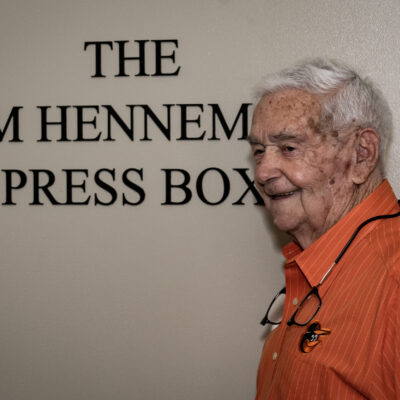
With the Orioles having just wrapped their 70th season, it seems as good a time as any to turn back the clock another 10 years and revisit the day when the whole journey was put in motion.
It was 80 years ago, Oct. 9,1944, that 52,833 people literally crashed the gates at the antiquated Municipal Stadium to watch a baseball game between the then-minor league Baltimore Orioles and the Louisville Colonels. At least that’s how many they were able to count. There were widespread reports that thousands more overwhelmed outmanned ticket takers to witness what became a turning point in Baltimore baseball history.
“The Game,” as it became known many years later, was the fourth in a best-of-seven series. After trailing 5-0 early, the O’s rallied to score four runs in a furious comeback bid that fell just short. But they would eventually capture what was billed as the Junior World Series—the unofficial minor league championship—and set the stage for bigger things to come. Namely, the return of Major League Baseball to Baltimore in 1954.
The 1944 season was the first time in almost two decades (they also beat Louisville in 1925) that the Orioles advanced to the JWS. The city was primed for the excitement of the series, a positive development at a dire time. The United States was fighting World War II on two continents, and on both our coasts, lamplighters and blackouts were daily routines. Turmoil seemed to be the order of the day and entertainment was virtually non-existent.
An industrial town, Baltimore was heavily invested in the country’s defense, building more than 5,200 B-26 bombers during the war at the Glenn L. Martin Company in Middle River and more “Liberty” ships at the Bethlehem-Fairfield shipyards (384) than any other port in the country. Baseball, popular before the war, became a favorite diversion during the war. The anticipation of that 1944 Junior World Series created the kind of buzz unknown in Baltimore in those days. Today, it’s remembered only by octogenarians-plus.
The game not only drew the attention of Major League Baseball, but also an entire nation starved for affirmative news and happenings. The crowd was the largest in minor league history and the series itself outdrew the World Series, which ironically was played in St. Louis between the Cardinals and Browns—the club that would move to Baltimore only 10 years later.
Ironically, none of that would have happened, at least not on the same timeline, had it not been for a fire that burned down Oriole Park a mere three months earlier, on the night and early morning of July 3-4. That fire, and the ensuing post-season series, set the stage for Baltimore’s re-entrance to the big leagues, while also inflaming an early brand of Orioles Magic—which began in a radio station and revolved around a magical chair.
On occasions when the O’s needed a rally, Bill Dyer, the team’s energetic and imaginative play-by-play announcer, would often take a walk around the “little red chair” in his radio booth. Thanks to the magic of teletype, not to mention a convenient delay, he had an amazing degree of success during road games, and enough with home games, to convince the fan base that his magical powers were real. Dyer was a longtime local legend, and he was widely credited with drumming up the enthusiasm that led to the record-breaking crowd that opened the doors to the big leagues.
But it all started with the Fourth of July fireworks that destroyed Oriole Park at 29th and 30th Streets and Greenmount Avenue (home plate was closer to Barclay and 29th.) That cozy park did not have the capability of handling more than 10,000 fans, if that. So, when the team was forced to move into Municipal Stadium on 33rd Street—the future home of beloved Memorial Stadium, of course—it was considered a temporary residence in a seldom-used facility better suited for the high school and U.S. Naval Academy football games played there.
The Junior World Series and “The Game”—and then a major Army vs. Navy college football battle at the same venue—led to the developments that changed all that.
Less than two months later after the minor-league O’s won the Junior World Series four games to two, the Army-Navy football game was played in Baltimore for the second time—1924 had been the first. The Dec. 2, 1944 game, billed as college football’s “Game of the Century,” featured the top two teams in the country and Baltimore served as the coming out party for Mr. Inside (Glenn Davis) and Mr. Outside (Doc Blanchard) as Army upset Navy, 23-7.
Initially, the game was scheduled for Navy’s Thompson Field in Annapolis, which had a capacity of 19,000. Because of the unprecedented interest in the game, officials decided to move the location. Although New York and Philadelphia were also considered, Baltimore’s Municipal Stadium was announced as the site less than three weeks before.
Whether or not the Orioles’ Junior World Series record-breaking attendance had any influence on the decision is open to speculation. Nonetheless, with tickets available only to those who purchased war bonds, the original “Game of the Century” drew a sellout crowd of 66,659.
Two years later, in 1946, the still-minor league Orioles season attendance topped 700,000, putting Baltimore squarely on MLB’s map. The transition from Municipal to Memorial Stadium had begun. And less than 10 years after the fire and minor-league game that sparked the dream, the Orioles were back in the major leagues.
Jim Henneman is a past president of the Baseball Writers’ Association of America and is now in his eighth decade covering and writing about the Orioles. He began his career with the Baltimore News American before joining the Baltimore Sun and has been a longtime PressBox columnist and contributor.
